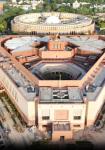A quiet but major change has occurred over the past 16 months in Indian politics: Dr Manmohan Singh, long considered a political novice and lightweight, has emerged as an assertive leader in his own right.
Not many political pundits have noticed Dr Singh's metamorphosis both because it has been so inconspicuous, and because they are reluctant to acknowledge it. But the change is real. Nothing proves this more strongly than some of Dr Singh's recent decisions and his address to the just-concluded Congress chief ministers conclave, where he spoke less like an economic administrator than like a seasoned politician.
Dr Singh has come a long way from being Congress President Sonia Gandhi's surrogate who was nominated to be prime minister only because she renounced that position. When he was sworn in, many forecast that he would remain under her shadow, consult her on every issue, and take commands from her.
Many pundits predicted duopoly: two centres of power, one (Ms Gandhi's) greater than the other; or separation between political and economic decision-making. Ms Gandhi would retain primacy in the first; Dr Singh in the second.
This theory started looking shaky early on. Dr Singh hand-picked his team. Significantly, this included Pranab Mukherjee, a known security hawk, and Montek Singh Ahluwalia, a committed neoliberal, with a strong International Monetary Fund-World Bank background. Ahluwalia would be at least as important as, if not more so than, Finance Minister P Chidambaram. As Planning Commission deputy chair, he would keep a check on the government's economic priorities and central expenditure. Ultimately, Chidambaram is a politician, who cannot ignore his constituency. Ahluwalia has no popular constituency.
However, Singh soon dealt another blow to the duopoly hypothesis. He followed Vajpayee in establishing a strong Prime Minister's Office, with its own independent staff. He had definite ideas about who would be in the Planning Commission or head the Indian Council of Social Science Research.
In the first three months of his tenure, Dr Singh vetoed more appointments than he approved. Soon, he quietly started asserting himself in areas such as foreign policy. His style wasn't confrontational, but beneath the polite, soft-spoken exterior lay a hard-nosed, shrewd persona.
This was first revealed 14 years ago when Dr Singh inaugurated India's transition to a neoliberal, market-driven economy. He seized on a transient balance-of-payments crisis to drive a long-term agenda of deregulation, cutbacks in social expenditures and public sector privatisation. Contrary to what many critics said, this agenda was only partially dictated by the IMF-World Bank. Much of its inspiration came from within the Indian establishment, including Prime Minister Narasimha Rao and Dr Singh.
Today, Dr Singh has emerged from Ms Gandhi's shadow. He's his own man, with definite ideas, projects, policies and preferences. Those who have interacted with him both from within government and outside testify to this. This evolution in part follows the power of his office. It cannot be otherwise in a Westminster-style democracy, where the prime minister does not preside over a collegium, but is pre-eminent -- indeed all-important. The PMO multiplies the effect, through its managers, fire-fighters and spin-doctors.
So far, this seems pretty straightforward. But what's remarkable is that Dr Singh is attempting a virtual political miracle. He leads -- after a fashion -- a party with no more than 145 seats in the 545-strong Lok Sabha. And yet he rules as if he commanded a single-party majority! This is partly explained by the ideologically disparate, fragmented nature of the Congress's United Progressive Alliance partners (mostly regional or OBC parties) and their distance from the government's 'outside' supporters (especially the Left, but also the Bahujan Samaj Party and Samajwadi Party).
Yet another crucial factor is the absence of an explicit Left-of-Centre current inside the Congress. For the first time in its many years in power, the party has no coherent Left-leaning forum or pressure-group comparable to the Congress Socialist Party, the Young Turks, or the Nehru Forum of the past.
Dr Singh also leaves most party-level political negotiation to others, including Ms Gandhi, while concentrating on government. Thus, UPA chairperson Ms Gandhi 'handles' the Congress's allies. But she has been effectively finessed from many areas of policy-making -- e.g. foreign affairs and security. And Dr Singh has extended his influence to these.
The present, somewhat peculiar, balance-of-power and division of labour has allowed the PM to exercise disproportionate influence and become increasingly autonomous of the Congress apparatus. His own political personality is becoming clear. Regrettably, that personality has its angularities and a dark, conservative, side.
Dr Singh came to power on a broad Left-of-Centre platform. But his instinctively preferred policies are Right-of-Centre. This is not a pejorative, but an analytical, description. Evidence for it comes from numerous decisions attributable to Dr Singh
and his confidants.
Take economics. Dr Singh has been content to follow the 'free-market' orientation of the National Democratic Alliance --barring on the National Rural Employment Guarantee Act, the UPA's single greatest achievement. He has continued with the NDA's macro-economic approach, taxation policies, resource mobilisation and allocation priorities, emphasis on foreign investment and globalisation, and public sector divestment.
Three of Dr Singh's top priorities are labour 'reform' (read, removal of worker protection and hire-and-fire policies), opening up retail trade to foreign investment (which could ruin millions of small traders and vendors), and sealing skewed trade-related agreements on agriculture and services through the World Trade Organisation. India compromised on this last at the Geneva ministerial meeting last year by breaking ranks with the developing countries' G-20 group -- in contrast to its firm position at Cancun. India's stand at the coming Hong Kong meeting will substantially impact its economy.
Last year, Dr Singh talked of empowering the underprivileged. Now, he only talks of GDP growth. In his Independence Day address, he said: 'If we maintain this momentum of growth (approximately 7 percent) for the next 5 to 10 years, then it would be possible for us to eradicate poverty, ignorance, hunger and disease... This is not a dream...' This regurgitates the notorious trickle-down theory, which stands belied by India's own experience.
India's current growth rate is about double the 'Hindu' rate (3 to 3.5 percent) 20 years ago. But higher growth means rising unemployment, and growing regional and class disparities.
It's not difficult to understand Dr Singh's inspiration. Like many (but not all) Indian decision-makers, he concluded after the end of the Cold War that there's no alternative to neoliberalism. You must play the market game, or lose out. This is disputable. There's evidence that vast numbers of people, including in the developed countries, are looking for democratic, non-market alternatives that put equity and justice before profit. But Dr Singh remains conservatively attached to the neoliberal framework.
It's in the foreign and security policy areas that Dr Singh's conservatism is distinctive. This is focused less on the neighbours than on the Great Powers, especially the United States and the European Union, and on nuclear weapons. Dr Singh hasn't engaged Bangladesh and Nepal, especially the Nepali people's struggle to tame a monarchy gone berserk. He has continued the NDA's policy of befriending China and talking peace with Pakistan.
But he has imparted a new turn to Indo-US relations and hardened India's nuclear weapons policy, even though he promised to return to the global disarmament agenda. Ms Sonia Gandhi has recused herself from these decision-making domains --because she has been so advised, thanks to her 'foreign origins.' The decision to sign the defence cooperation and nuclear deals with the US in June and July was very much Dr Singh's. As was the September 24 vote at the IAEA wrongly accusing Iran of 'non-compliance' with the NPT.
By all accounts, Dr Singh was greatly impressed by President Bush's interest in India as an 'emerging' power and 'partner.' He weighed this much higher than either principle or even India's self-interest -- in energy security via Iran and Central Asia, or the larger issue of Asian economic integration. Dr Singh's major Rightward turn could cost India dearly because of its lopsidedness and preoccupation with making India the US's junior ally.
The Left parties have strongly objected to these policy shifts. Instead of building a consensus with them, Dr Singh has unleashed scarcely veiled attacks on them. On October 9, he told Congress CMs: 'Our people are patriotic. They understand what is in the best interest of our country... The party must explain what our thinking in government is... It must ensure that deliberate disinformation by vested interests is countered... The people of India will never question the patriotism of the Congress party... We have only one intention and one motivation. To build an India that is strong, that is prosperous that is
liberal and caring, that is inclusive and secular.'
Such rhetoric is unlikely to settle matters. The Left, and Centrist parties like the SP and Janata Dal (Secular), are deeply offended by the UPA's Iran and US policies and are launching a campaign against them. This could lead to a serious confrontation. If Dr Singh wants to avoid it, he should clip his ambitions and respect coalitional consensus.





